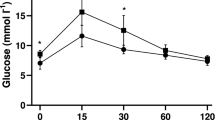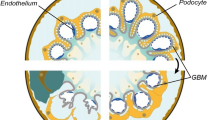Summary
There is evidence that the rarefaction of the capillary bed is typical for the skeletal muscle of spontaneously hypertensive rats. We were therefore interested to learn whether there is also a rarefaction in skeletal muscle of human hypertensives. The number of capillaries was morphometrically analysed and counted in the quadriceps and the pectoralis major muscles of human normotensives (n=12) and hypertensives (n=15). The clinical diagnosis and certain pathological criteria, such as blood pressure (with or without antihypertensive therapy), heart weight, left ventricular wall thickness, the state of kidney arterioles and brain, and heart vessels, were used to classify the patients into two groups. The dissected tissue samples were prepared according to the GMA method and the capillary numbers per area were counted using light microscopy (250×). The quadriceps muscle had a capillary density (per 2.5 mm2) of 442±51 in normotensives and 277±41 in hypertensive patients; in the pectoralis major muscle we counted 477±30 in controls and 232±28 in hypertensives. The rarefaction in the quadriceps muscle ranged by about 37%, in the pectoralis major muscle by about 51%. It is suggested that the reduction of the capillary surface area caused by the capillary rarefaction reduces the transcapillary fluid exchange and in that way prevents an overperfusion of the terminal vascular bed.
Similar content being viewed by others
Abbreviations
- A3:
-
Terminal arteriole
- A4:
-
Precapillary arteriole
- GMA:
-
Glycolmethacrylate
- M:
-
Musculus or muscle
- N:
-
Numbers counted
- NR:
-
Normotensive (nonrelated) Wistar rat
- SHR:
-
Spontaneously hypertensive rats
- WHO:
-
World Health Organisation
- WKY:
-
Wistar Kyoto normotensive rat
References
Bohlen HG, Gore RW, Hutchins PM (1977) Comparison of microvascular pressures in normal and spontaneously hypertensive rats. Microvasc Res 13:125–130
Chen IIH, Prewitt RL (1983) Capillary pressure gradients in cremaster muscle of normotensive and spontaneously hypertensive rats. Microvasc Res 25:145–155
Chen IIH, Prewitt RL, Dowell RF (1981) Microvascular rarefication in spontaneously hypertensive rat cremaster muscle. Am J Physiol 241:H306–310
Folkow B (1982) Physiological aspects of primary hypertension. Physiol Rev 62:347–504
Gray SD (1982) Lack of capillary “rarefication” in skeletal muscle of spontaneously hypertensive rats. In: Rascher W, Clough D, Ganten D (eds) Hypertensive mechanisms. Schattauer, Stuttgart-New York, pp 204–207
Gray SD (1984) Morphometric analysis of skeletal muscle capillaries in early spontaneous hypertension. Microvasc Res 27:39–50
Hartper RN, Moore MA, Marr MC, Watts LE, Hutchins PM (1978) Arteriolar rarefaction in the conjunctiva of human essential hypertensives. Microvasc Res 16:369–372
Harper S, Bohlen HG (1984) Microvascular adaptation in the cerebral cortex of adult spontaneously hypertensive rats. Hypertension 6:408–419
Heine H (1973) Helle Kerne im Myokard von Säugetieren unter normalen Bedingungen. Z Mikr-Anat Forsch 87:272–286
Heine H (1973) Zur Entwicklungsgeschichte angeborener Zwerchfellhernien bei Säugetieren. Anat Anz 133:382–393
Henrich H, Heine H (1979) Further evidence for capillary rarefication and reduced arteriolar ramification in spontaneously hypertensive rats. Microvasc Res 18:451
Henrich H, Hertel R (1979) Hemodynamics and rarefication of the microvasculature in spontaneously hypertensive rats. Bibl Anat 18:184–186
Henrich H, Assmann R, Hertel R, Hecke A (1977) Die Stromstärke als geregelte Größe der essentiellen Hypertonie — Quantitative Untersuchungen der Mikrozirkulation in SHR und NR. In: Schaper W, Wüsten B (eds) Hoher Blutdruck. Steinkopf, Darmstadt, pp 200–201
Henrich H, Hertel R, Assmann R (1978) Structural differences in the mesentery microcirculation between normotensive and spontaneously hypertensive rats. Pflügers Arch 375:153–159
Henrich H (ed) (1982) Microvascular aspects of spontaneous hypertension. Hans Huber, Bern-Stuttgart-Vienna
Honig CR, Frierson JC, Patterson JC (1970) Comparison of neural controls of resistance and capillary density in resting muscle. Am J Physiol 218:937–942
Hudlicka O, Dodd L, Renkin EM, Gray SD (1982) Early changes in fiber profile and capillary density in long-term stimulated muscles. Am J Physiol 243:H528-H535
Hutchins PM, Darnell AE (1974) Observation of a decreased number of small arterioles in spontaneously hypertensive rats. Circ Res [Suppl 1] 34/35:161–165
Lang J (1977) Angioarchitektonik der terminalen Strombahn. In: Meesen (ed) Mikrozirkulation. Hdbch Allgem Pathologie. Springer, Berlin-Heidelberg-New York, pp 1–134
Myrhage R, Hudlicka O (1978) Capillary growth in chronically stimulated adult skeletal muscle as studied by intravital microscopy and histological methods in rabbits and rats. Microvasc Res 16:73–90
Prewitt RL, Johnson PC (1976) The effect of oxygen on arteriolar red cell velocity and capillary density in the rat cremaster muscle. Microvasc Res 12:59–70
Ruddell CL (1967) Hydroxyethyl methacrylate combined with polyethylene glycol 400 and water, an embedding medium for routine 1–2 micron sectioning. Stain Technol 42:119–123
Skolasinska K, Funk R, Günther H, Harrison DK, Höper J, Eichhorn M, Lütjen-Drecoll E (1983) Local oxygen supply of the brain cortex of spontaneously hypertensive rats in relation to the arrangement and structure of arterioles and capillaries. J Cerebr Blood Flow [Suppl 1] Metab 3:14–15
Sokolova IA, Radionov IM, Blinkov SM (1981) Rarefaction of capillary network in the brain of rats with induced Doca-Saline and renal hypertension. Microvasc Res 22:125–126
Sokolova IA, Manukhina EB, Blinkov SM, Koshelev V, Pinelis VG, Rodionov IN (1985) Rarefication of the arterioles and capillary network in the brain of rats with different forms of hypertension. Microvasc Res 30:1–9
Vetterlein F, Schmidt G (1980) Functional capillary density in skeletal muscle during vasodilation induced by isoprenaline and muscular exercise. Microvasc Res 20:156–164
WHO Expert Committee (1978) Arterial hypertension. WHO Technical Report Series 628, Geneva
Author information
Authors and Affiliations
Rights and permissions
About this article
Cite this article
Henrich, H.A., Romen, W., Heimgärtner, W. et al. Capillary rarefaction characteristic of the skeletal muscle of hypertensive patients. Klin Wochenschr 66, 54–60 (1988). https://doi.org/10.1007/BF01713011
Received:
Revised:
Accepted:
Issue Date:
DOI: https://doi.org/10.1007/BF01713011




